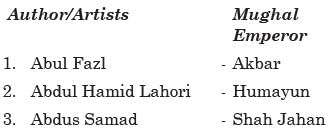Test: History & Culture - 6 - UPSC MCQ
25 Questions MCQ Test - Test: History & Culture - 6
Consider the following statements:
1. Kshatriya reaction against Brahmanical domination
2. Spread of new agricultural economy
3. Rise of new cities in northeastern India
4. Practicing the doctrine of non-violence
Which of the above is/are the reasons for the origin of Buddhism and Jainism?
1. Kshatriya reaction against Brahmanical domination
2. Spread of new agricultural economy
3. Rise of new cities in northeastern India
4. Practicing the doctrine of non-violence
Where was “Prati Sarkar” or parallel government set up under Nana Patil during the Quit India Movement?
| 1 Crore+ students have signed up on EduRev. Have you? Download the App |
Under which Mughal emperor reign, artist Mir Sayyid Ali was present?
Consider the following statements:
1) Mansab fixed the status of the Mansabdar in the official hierarchy but not his salary.
2) Mansab did not fix the number of armed retainers that the Mansabdar was supposed to maintain.
3) Mansabdari was a single service combining both civil and military responsibilities.
4) All holders of Mansab were called “Amir-e-Azam”.
Which of the statements given above is/are correct?
With reference to ‘Badshah-Nama’, consider the following statements:
1. It was written by Abdul Hamid Lahori.
2. It gives detailed account of reign of Mughal emperor Jahangir.
Which of the above statements is/are correct?
Which of the following Muslim League leaders joined the Home Rule League founded by Annie Besant?
Consider the following statements with respect to ‘Great’ and ‘Little’ Traditions:
1. Great Tradition emanated from dominant social categories like priests and rulers.
2. Little tradition refers to great tradition tailored according to regional and village conditions.
Which of the above statements is/are correct?
During the Indian freedom struggle, who of the following started the weekly “Yugantar” in April 1906?
Consider the following statements:
1. Harihara and Bukka were the founders of the Vijaynagara Empire.
2. They were the contemporaries of Mohammad Bin Tughlaq.
Which of the above statements is/are correct?
Which of the following did NOT take place during the administration of Lord Dalhousie?
Select the correct statement regarding Tantric worship:
“He emerged as one of the leading proponents of Vaishnavism in Assam. His teachings, often known as the Bhagavati Dharma, focused on absolute surrender to the supreme deity. He emphasized the need for naam kirtan; recitation of name of Lord in satsanga or congregations of pious devotees, His major composition includes the Kirtanaghosha”. Identify the personality discussed in the above passage:
Consider the following statements:
1. Sufism was initiated as a result of protest against the growing mysticism and asceticism of the Caliphate.
2. Sufi saints interpreted Quran based on their personal experiences.
3. The Sufis organized communities around a hospice called ‘dargah’.
4. Chisti order was named after its founder Khwaja Muinuddin Chisti.
Which of the above statements is/are incorrect?
Consider the following pairs:

Which of the above pairs is/are correctly matched?
Consider the following statements regarding the economy of the Vijaynagara Empire:
1. Trade was contributing more to the revenue of the empire than agriculture.
2. The society was highly egalitarian.
3. Only gold coins were in circulation in the economy.
Which of the above statements is/are incorrect?
Arrange the following Mahajanapadas that came into existence in 6th century BC from North to South:
1. Avanti
2. Taxila
3. Magadha
4. Koshala
Select the correct answer using the code given below:
The famous ‘Kadaram Campaign’ was undertaken by which Indian Kingdom?
Consider the following statements regarding the ancient Indian Mahajanapadas that came into existence during the sixth-century B.C. :
1. No Mahajanapada was located in Gangetic delta.
2. All Mahajanapadas were monarchical where power was exercised by a king.
3. The term Janapada is known from the days of the vedic literature.
Which of the above statements is/are correct?
Hostilities between the powers to the north and to the south of the Tungabhadra river became a regular and recurrent feature during the early medieval times. This hostility pattern was seen between which of the following kingdoms?
1. Chalukya-Pallava
2. Pallava-Rashtrakutas
3. Rashtrakutas-Cholas
Select the correct answer using the code given below:
Vijaynagara Empire was defeated at the Battle of Talikota (1565) by the combined armies of:
Consider the following statements regarding the Amara-Nayaka system of the Vijaynagara Empire:
1. Amara-Nayaka system was a major political innovation of the Vijayanagara Empire influenced by the Iqta system of the Delhi Sultanate.
2. Amara-Nayakas were military commanders who were given territories to govern without any financial responsibilities.
Which of the above statements is/are correct?
“It is situated in Indian state of Uttar Pradesh. It is famous for prehistoric sites, which is related with paleolithic, mesolithic and megalithic periods”.
Which of the following archaeological sites is discussed in the above passage?
Consider the following statements regarding the Mauryan Empire:
1. Chandragupta Maurya was an autocrat who concentrated all power in his hands.
2. The largest expansion of the empire took place under King Ashoka.
Which of the statements given above is/are correct?
Consider the following statements:
1. Harappan script is regarded as pictographic script.
2. The Harappan script was boustrophedon, written from left to right and right to left in alternate lines.
3. The Harappan script has not been deciphered yet.
Which of the above statements is/are correct?


















